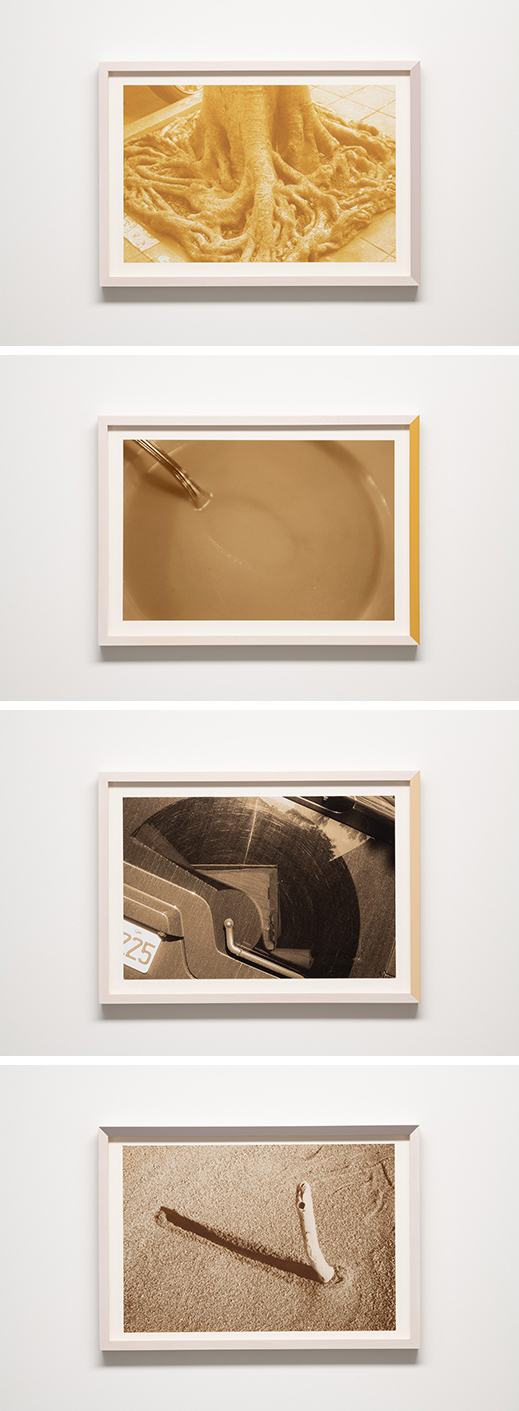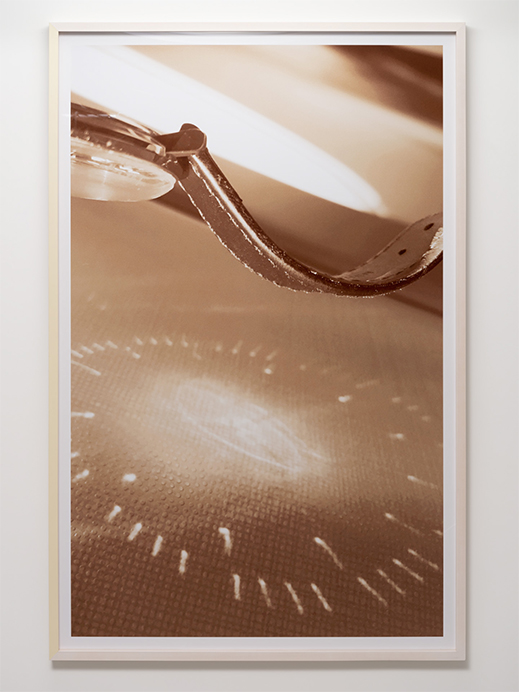 |
|
Here and There introduces art, artists, galleries, museums, and other cultural facilities around Japan that non-Japanese readers and first-time visitors may find of particular interest.
|
|
 |
|
|
 |
 |
Reality Sliced and Diced: Hirofumi Isoya at SCAI Piramide
Alan Gleason |
 |
Installation view of "Go, go, go, said the bird: humankind cannot bear very much reality" (2021) by Hirofumi Isoya. In the foreground is Flowers and Bees, Translucent Archive (2018), honey, fishing lights, glass bottles. |
Hirofumi Isoya deals in riddles, optical illusions and visual paradoxes. His works in multiple media are never quite what they seem -- though the first impressions they spark, sans any information about the artist's intentions, are often the most striking. That was my experience, anyway, at a solo show of his recent works at SCAI Piramide, a new exhibit space opened in April this year in Roppongi, Tokyo by the well-known contemporary art gallery SCAI The Bathhouse.
Isoya's title for the exhibition, "Go, go, go, said the bird: humankind cannot bear very much reality", is a quote from a poem by T.S. Eliot. And indeed, the artist seems determined to show us just how readily we cobble together our own arbitrary meanings from ambiguous images and events. But he is not merely a conceptualist. With degrees in both fine art and architecture, Isoya (b. 1978) takes an artisan's delight in the craft of constructing his multimedia installations from a diversity of materials, and this show is no exception. However, while it includes a number of 3D works and one room-sized installation, mostly it consists of sepia-toned, framed enlargements of iPhone snapshots.
|
Quiet Passenger or Intruder (2016-2018), pigment print, painted frame.
|
|
Flesh Light (2018), pigment print, painted frame. |
Here Isoya utilizes the medium of the photograph to play tricks, often very amusing ones, on our eyes. Quiet Passenger or Intruder (the work titles have all been translated into English by the artist) is a close-up of a ladybug sitting placidly on what looks like an expanse of flawless, gently curving female skin. So it can be something of a letdown to learn from a gallery staffer that the "flesh" is actually the faux leather of an airplane interior, the curve is the edge of a window, and the bug really did make its way on board somehow, where it was discovered by Isoya. A bit anticlimactic, but droll too, and point well taken about first impressions.
Or consider Flesh Light, which depicts what appears to be a withered leaf or perhaps a wasp's nest, suspended against a blurry backdrop of what may be electric light bulbs. According to my informant, the object is actually a lump of raw ham, turned on its side -- definitely an exercise in trompe-l'oeil.
|
 |
|
|
|
Four vertically stacked images. From top to bottom: Growth (2016), pigment print, painted frame; Rilievo (2014-2018), pigment print, painted frame; Wiping a View (2016), pigment print, painted frame; Shadow Bed (2015), C-print, painted frame.
|
Among the most enjoyable examples of Isoya's dalliances with forms are two series of four small prints that share nothing in common content-wise, yet contain shapes that the viewer's eye willfully picks up as a repeated motif. The four images arranged on the wall as shown here are utterly disparate: they appear to portray the exposed roots of a tree; a spoon dipped in soup; some sort of drafting tool leaving circular traces; and a stick or other long object casting its shadow on a trail it has left in sand. But stack them like this, and the eye immediately hones in on the recurring stick-and-circle image, reminiscent of the gnomon on a sundial. Another four-photo series produces the same effect via the repetition of a silhouette whose vaguely birdlike shape is reinforced by the actual figures of birds (stuffed or models? it's not clear) that appear in one shot.
|
 |
|
|
|
Dial of Inversion (2017-2020), pigment print, painted frame
|
One of the most compelling photographs, not least because it stands nearly two meters high on the floor, is an enigmatic juxtaposition of three luminous objects -- one of which is attached to a flexible strap of some kind. Once again, it took some curatorial guidance for me to realize that the strap connects to an inverted watchface, through which a fluorescent light source above it casts a dial-like reflection on the surface below. The work also has one of Isoya's more literal titles: Dial of Inversion.
These and most of the other framed prints lining the walls of the main gallery have been rendered in a sepia monochrome, but the artist alludes to their original colors by painting one side of each frame in a hue derived from the image. Thus the spoon-in-soup shot is partially framed in yellow (corn potage?), while the ladybug on the airplane wall is accompanied by a strip of bright red. Without supplementary explanation the effect is purely subliminal, which is no doubt what the artist was aiming for.
A long, low dais in the center of the main room supports two distinct but linked installations. At one end, three tan-colored and seemingly identical 25-centimeter spheres form a billiards-like tableau. These belong to Isoya's Activation series, for which he pulverized pieces of earthenware dating back to 3500 to 2500 BCE, then reshaped and fired the clay into these very solid, smooth globes. The dubious treatment of ancient artifacts implicit in this process prompted me to ask what that was all about, but I was assured they were legitimately purchased by the artist. What I initially found most intriguing about the trio of spheres, however, was their placement: two very close together, the third at a bit of a remove. The proximity of the first two made their mutual gravitational pull almost palpable, while the third, by dint of being just a few inches further away, seemed oblivious and isolated.
 |
|
Installation view; in the foreground (from left to right) are Activation 03, 01, and 02 (2021), ancient earthenware fragments from 3500-2500 BCE, clay. |
At the other end of the dais sit three similarly arrayed, but larger, oblong objects: glass jars connected to the ceiling by long vertical cords. Collectively titled Flowers and Bees, Translucent Archive, the jars are filled with honey and emanate a sublime reddish glow that comes from fishing lamps inside. Isoya explains that this is an organic sculpture highlighting the remarkable qualities of honey, a substance with powerful antibacterial and preservative properties that is the product of tremendous energy expenditure by the bees that make it. Here the honey softens the artificial LED light, while the faint heat from the lamp causes the liquid to slowly circulate in the jar.
|
 |
|
|
|
Palilalia and Heat (2021), LED light, chains, refined beeswax, moth scales.
|
A dark room separate from the main gallery holds a bit of a surprise: the only object in it is a single red LED tube in the far corner. Suspended diagonally from the ceiling, it has a number of small metal chains dangling from it in semicircular arcs. The warm red glow suffusing the entire space is somehow soothing, even if the chains remain a mystery. Once again, the handout comes to the rescue: the chains affixed to the light are coated with moth scales mixed into beeswax, evoking "insects that fly towards and strike against the light source perceived as moonlight." Come to think of it, bugs are a recurring motif in this show, though what they signify to Isoya is left open to conjecture.
Overall, I find that the imagery of Isoya's installations, and his playful manipulations of it, are fascinating enough to make an exploration of his universe worthwhile, never mind what hidden metaphors it may or may not reveal. By slicing and dicing our visual reality in his works, he slyly nudges us, with a laugh or two along the way, toward a sharper awareness of the hapless subjectivity of our perceptions.
The exhibition at SCAI Piramide is up until 16 October. More works by Isoya can also be viewed on this website.
All works shown are by Hirofumi Isoya; all photos are by Nobutada Omote, courtesy of SCAI The Bathhouse. |
 |
| Hirofumi Isoya: "Go, go, go, said the bird: humankind cannot bear very much reality" |
| 9 September - 16 October 2021 |
| SCAI Piramide |
3F, Piramide Building, 6-6-9 Roppongi, Minato-ku, Tokyo
Phone: 03-6447-4817
Hours: 12 noon - 6 p.m. Closed Sunday, Monday, Tuesday, Wednesday, and public holidays
Access: 2-minute walk from Exit 1 or 3, Roppongi Station on the Tokyo Metro Hibiya Line or Toei Subway Oedo Line
|
|
|
|
| |
 |
Alan Gleason
Alan Gleason is a translator, editor and writer based in Tokyo, where he has lived for over 30 years. Since 2006 he has edited artscape Japan and written the Here and There column, as well as translating the Picks reviews. He also edits and translates works on Japanese architecture, music, and theater. |
|
|
|
|
|
|
|
|
|
 |
|